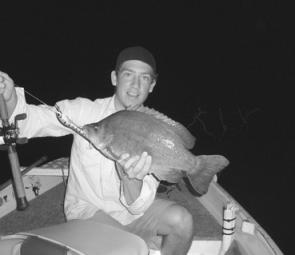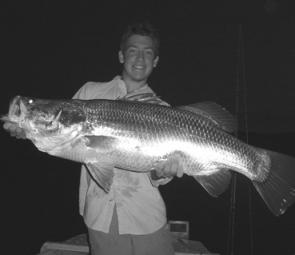David Mayes and Carl Shuster returned to Cairns recently with one thing on their minds: barramundi. The boys are always keen to chase barramundi and, with the closed season in place, decided to head down to Peter Faust Dam for a three-day trip to find out what all the fuss was about. They weren’t disappointed!
Whenever you find yourself fishing new grounds it usually time to set-up a game plan. This time the boys were catching fish almost straight away and simply repeated successful tactics from previous trips whilst adapting to the local conditions.
A sounder is essential when trying to identify where underwater structure is located and the contour lines of the banks to establish where the barra might be holding. Once the boys worked out some trolling runs it was down to business and the usual lures, Vipers, RMG's, Barra Classic's, started producing good barramundi.
David trolled well on Day 1 landing a very healthy 90cm barra on a Viper as well as a couple of thumper sooties. Peter Faust Dam has some massive sooties, which are often mistaken for barra and readily attack the bigger barra lures. Carl was surprised when his trolled Viper was eaten by a big 1m+ barra, which smashed him in the heavy timber. The boys thought they noticed some barra tailing in the shallows and decided they would give that a go on the next day.
Day 2 arrived and the boys headed back to the first contact spot. Their first two runs produced a fish each of 105cm and 106cm before they decided to check out the shallow weedbeds. Once again they sighted tailing barra and began casting fizzers, which produced a couple of smaller fish before calming down. David suggested they change over to casting shallow runners and it wasn't long before the barra came back on the chew with Carl picking up a 109cm beauty on a B52 lure. In the evening they decided to head for the dam wall and do some trolling. The boys rounded out the session with David landing a 90cm and 1m+ whilst Carl caught another barra over 1m.
Day 3 produced another great 106cm barra to Carl but didn’t see the boys reaching the heights of Day 2. Peter Faust has made quite an impression on the boys who are already planning another trip down to this increasingly popular freshwater destination.
Lure casting in the local estuaries has produced quite good numbers of mangrove jacks to 50cm and the usual smattering of 'other fish' including smallish GT's, flathead, cudas and cod with a few barra showing up. At this really hot time of year the best action is usually before daylight and a couple of hours after, especially if it coincides with the low tide changeover. I suggest getting on the water around 4.00am and fishing through till about 8.00am.
Local Cairns barra anglers have been patiently waiting for the opening of the 2006 season on the first day of this month. The tropical weather pattern has again been disappointing as we have yet to experience the significant rainfall that is so important for the big breeding barra to complete an effective spawning cycle. So as the season opens vulnerable large breeding barra may be removed from the fishery before spawning, as they hold off for the onset of essential rains.
Hopefully the anglers of 2006 are more educated than those 15-20 years ago and with the influx of digital cameras, a memorable barra capture will be quickly recorded at the capture site and before releasing the fish to continue propagation of the species.
Baitfishing has produced some good fingermark in the deeper sections of the Cairns Inlet, jacks on the rising tide in the snags and out on the flats some grunter to 65cm are being taken on the top of the tide on flesh baits. There will be plenty of bait around for cast netters and early rains will mean an abundance of prawns about along the Cairns Esplanade.
In the local rivers there are good reports of schools of quality queenfish over 1m in most of the river mouths and these fish are great fun to catch on topwater poppers and slugs worked rapidly back to the boat. The queenies won’t be around once the heavy rain sets in and produces the first flooding of the rivers as this changes the salinity of the water and also washes the bait schools further out to sea.
If you want an enjoyable outing with a difference try the freshwater scene on foot. It’s been firing lately with plenty of action for light tackle lure casters chasing these small aggressive hard fighting fish such as jungle perch and sooty grunter. These fish are found in most of the upper reaches of our local rivers and streams. There aren’t too many secrets to the tropical freshwater experience, just use stealth and have a good selection of small lures and a very light, whippy outfit which casts small lures well. Take a small day pack with food, drink and the usual essentials and head off to trek on foot far up any of the many small streams that are located on the western side of the Bruce Highway between Ingham and Daintree. If you’re prepared to go exploring you will usually locate some good action and better quality fish.
Bottom fishers have been having plenty of success with large mouth nannigais and red emperor, particularly at night between the reefs in the deeper water around the 50-65m mark. Daytime has seen occasional good catches of coral trout and reds with reports that plenty of sharks are causing the usual summer time blues by stealing many fish before they make it to the boat.
In between the bottom fishing action, surface set lines have been producing occasional quality mackerel, cobia and GT's. There have been plenty of tuna schools between the reefs for anyone wishing to do a spot of 'chuna chucking' with metal slices. February should see this bottom fishing pattern continue and even improve if the water temperature cools off a bit. Anglers planning nighttime trips need to be careful of late afternoon/evening storms, which can be severe through the summer months.
Reads: 2780
David Mayes was impressed with the number and size of the sooty grunter available at Peter Faust Dam. This one took a trolled viper that was meant for a barramundi.

Carl Shuster holds a fabulous 106cm barramundi boatside prior to release. The big barra was one of many captured recently at Peter Faust Dam.

David Mayes was very happy with another big barramundi trolled up on a Viper lure from the heavy timber of Peter Faust Dam.




